CSAT Trends and Benchmarks for 2025
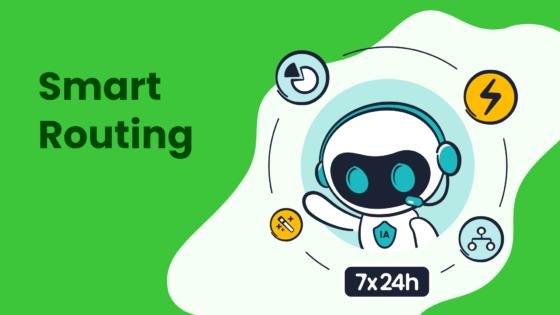
Customer satisfaction has become a cornerstone of business success in 2025. CSAT, or customer satisfaction score, measures how well you meet customer expectations. For example, industries like consulting boast CSAT scores as high as 84, while others like communication and media face challenges with scores as low as 22. Understanding these benchmarks helps you gauge your performance and identify areas for improvement.
CSAT scores are more than just numbers. They reveal customer sentiment, highlight pain points, and guide data-driven decisions. A good CSAT score can boost customer loyalty and lifetime value. Tools like Sobot empower you to achieve these outcomes by streamlining interactions and delivering exceptional customer experiences.
Understanding CSAT and Its Importance
What is CSAT and why it matters
CSAT, or customer satisfaction score, measures how happy your customers are with your product or service. It is calculated by asking a simple question, often through a survey: "How satisfied were you with your experience?" Customers respond using a scale, typically from 1 to 5, where 5 represents the highest satisfaction. This metric provides a snapshot of customer sentiment at specific touchpoints in the customer journey.
Why does CSAT matter? It acts as a health check for your business. A high CSAT score shows that you are meeting customer expectations, which can lead to repeat business and stronger loyalty. On the other hand, a low score highlights areas needing improvement. CSAT surveys also offer real-time feedback, helping you address issues quickly and improve the overall customer experience. In today’s competitive market, understanding customer feedback is essential for enhancing customer satisfaction and staying ahead.
The impact of a good CSAT score on business success
A good CSAT score directly influences your business outcomes. Studies show that companies with high customer satisfaction achieve nearly double the revenue growth of their competitors. Retaining satisfied customers is also more cost-effective than acquiring new ones. For example, improving CSAT by just a few points can help you retain 74% of your customers for an additional year, boosting profitability.
High CSAT scores also enhance operational efficiency. For instance, a 1% improvement in First Contact Resolution can reduce operating costs by 1%. Moreover, businesses with exemplary CSAT scores (above 90%) often enjoy stronger word-of-mouth referrals and higher customer lifetime value. These benefits make CSAT a critical metric for long-term success.
| CSAT Score Range | Implication |
|---|---|
| 75% - 85% | Solid performance, but with room for improvement. |
| Above 90% | Exemplary, correlating with higher loyalty and stronger referrals. |
How Sobot's Voice/Call Center supports CSAT improvement

Sobot’s Voice/Call Center plays a pivotal role in improving your CSAT score. Its intelligent IVR system ensures that customers reach the right agent quickly, reducing frustration. Features like real-time monitoring and AI-powered voicebots provide instant, accurate responses, enhancing the customer experience.
The platform also integrates seamlessly with your existing CRM systems, giving agents access to complete customer histories. This reduces repetitive questioning and improves first-contact resolution rates. With a 99.99% system uptime and global network support, Sobot ensures reliable service, even during peak times. By streamlining communication and offering personalized support, Sobot helps you deliver satisfaction at every step of the customer journey.
Key Metrics for Measuring Customer Satisfaction
CSAT: Definition, calculation, and applications
CSAT, or Customer Satisfaction Score, is one of the most effective tools for measuring customer satisfaction. It evaluates how satisfied your customers are with a specific product, service, or interaction. You calculate CSAT using the formula:
| Calculation Method | Description |
|---|---|
| CSAT Formula | CSAT = (Number of positive responses / Number of total responses) x 100 |
| Example | If you had 45 'satisfied' ratings out of 100 survey responses, your score would be 45. |
CSAT surveys typically ask customers a simple question, such as, "How satisfied were you with your experience?" Responses are collected on a scale, often ranging from 1 to 5. This metric provides a snapshot of customer sentiment at specific touchpoints.
You can use CSAT to identify areas for improvement and engage with customers who provide neutral or low ratings. Tracking CSAT over time offers insights into team performance and the effectiveness of your strategies. For example, a consistent rise in CSAT scores indicates that your efforts to improve customer satisfaction are paying off.
CES (Customer Effort Score): Measuring ease of customer interactions
CES focuses on the effort customers expend during interactions with your business. It measures how easy it is for customers to resolve issues, make purchases, or access services. Research shows that reducing effort leads to significant benefits:
| Statistic Description | Value |
|---|---|
| Reduction in resolution time with low effort scores | 42% |
| Increase in likelihood of repeat purchases with low effort | 94% |
| Decrease in likelihood to return with high effort | 61% |
| Increase in repurchase intention with reduced effort | 96% |
| Increase in customer satisfaction scores in easy-to-navigate stores | 88% |
| Increase in customer retention rates with reduced effort | 12% |
| Preference for brands that make resolving issues effortless | 63% |
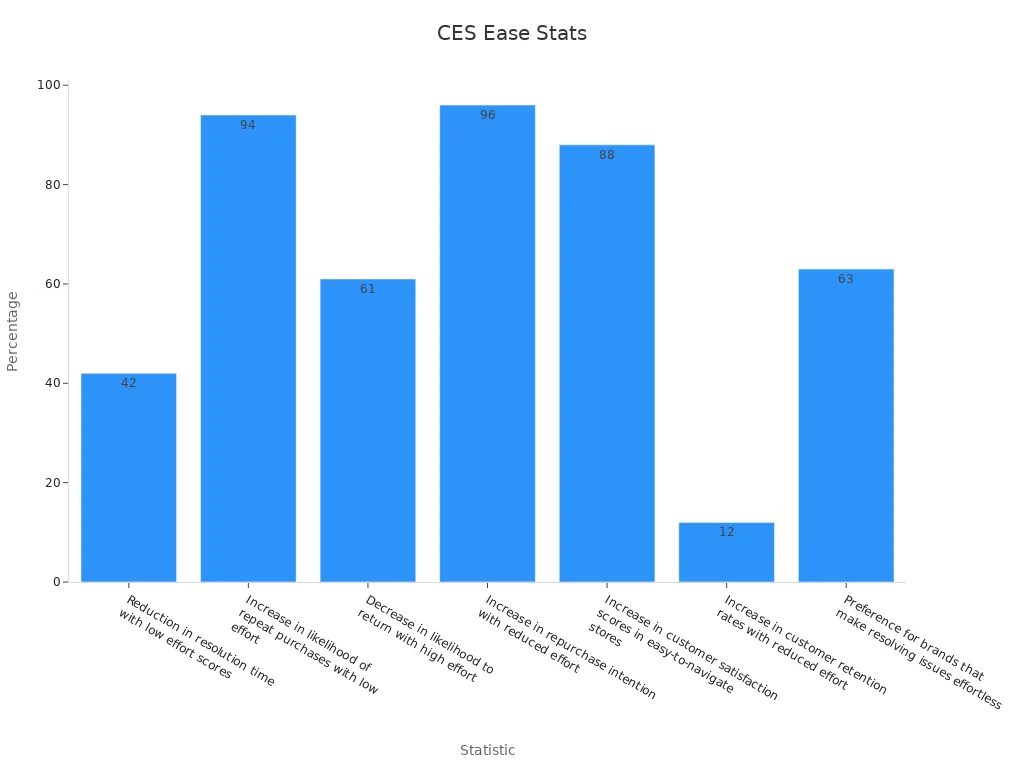
CES surveys ask questions like, "How easy was it to resolve your issue?" Lower effort scores correlate with higher satisfaction and retention rates. By simplifying processes and reducing friction, you can improve customer interactions and foster loyalty.
NPS (Net Promoter Score): Gauging customer loyalty alongside satisfaction
NPS measures customer loyalty by asking, "How likely are you to recommend our product or service to others?" Customers respond on a scale from 0 to 10, with scores grouped into three categories: promoters (9-10), passives (7-8), and detractors (0-6).
Studies show that NPS is a strong predictor of short-term sales growth. For example:
| Study | Findings |
|---|---|
| van Doorn et al. (2013) | NPS is a better predictor of short-term sales growth with a one-year time lag. |
| Morgan and Rego (2006) | Customer mindset metrics predict future performance for time lags of one to three quarters. |
| Williams and Naumann (2011) | Greatest impact observed with one-quarter time lags. |
While NPS reflects past customer behavior, it also highlights areas for improvement. Businesses with high NPS scores often enjoy stronger word-of-mouth referrals and increased customer lifetime value. By actively seeking feedback and addressing concerns, you can boost loyalty and satisfaction.
CSAT Benchmarks Across Industries in 2025

Banking and Financial Services: Benchmarks and trends
The banking industry continues to prioritize customer satisfaction as digital banking experience becomes the norm. In 2025, the average CSAT score for banking and financial services stands at 79%, reflecting steady performance. Banks are meeting industry standards by offering seamless online services, personalized financial advice, and secure transactions.
| Year | Average CSAT Score | Description |
|---|---|---|
| 2025 | 75% - 85% | Strong score indicates banks are meeting/exceeding expectations. |
| 2025 | 79% | Average CSAT score in banking and financial services sector. |

Digital banking experience plays a significant role in shaping satisfaction levels. Customers expect intuitive interfaces, quick issue resolution, and robust security measures. Banks that excel in these areas often achieve higher CSAT benchmarks. For example, integrating AI-powered solutions like Sobot’s Voice/Call Center can streamline customer interactions, reduce wait times, and enhance satisfaction.
The banking industry faces challenges in maintaining consistent service quality across channels. However, advancements in AI and automation are helping banks address these issues. By leveraging tools that unify communication and provide real-time insights, banks can improve their CSAT scores and foster loyalty.
Retail and E-commerce: Meeting customer expectations
Retail and e-commerce businesses consistently rank among the highest in CSAT benchmarks. In 2023, e-commerce companies achieved an average CSAT score of 80, showcasing their ability to meet evolving customer expectations. This trend continues in 2025, driven by personalized shopping experiences, fast delivery, and efficient post-sale support.
- In 2023, e-commerce companies achieved an average CSAT score of 80, which is among the highest across industries.
- Meeting evolving customer expectations is crucial for e-commerce businesses to enhance customer satisfaction before and after sales.
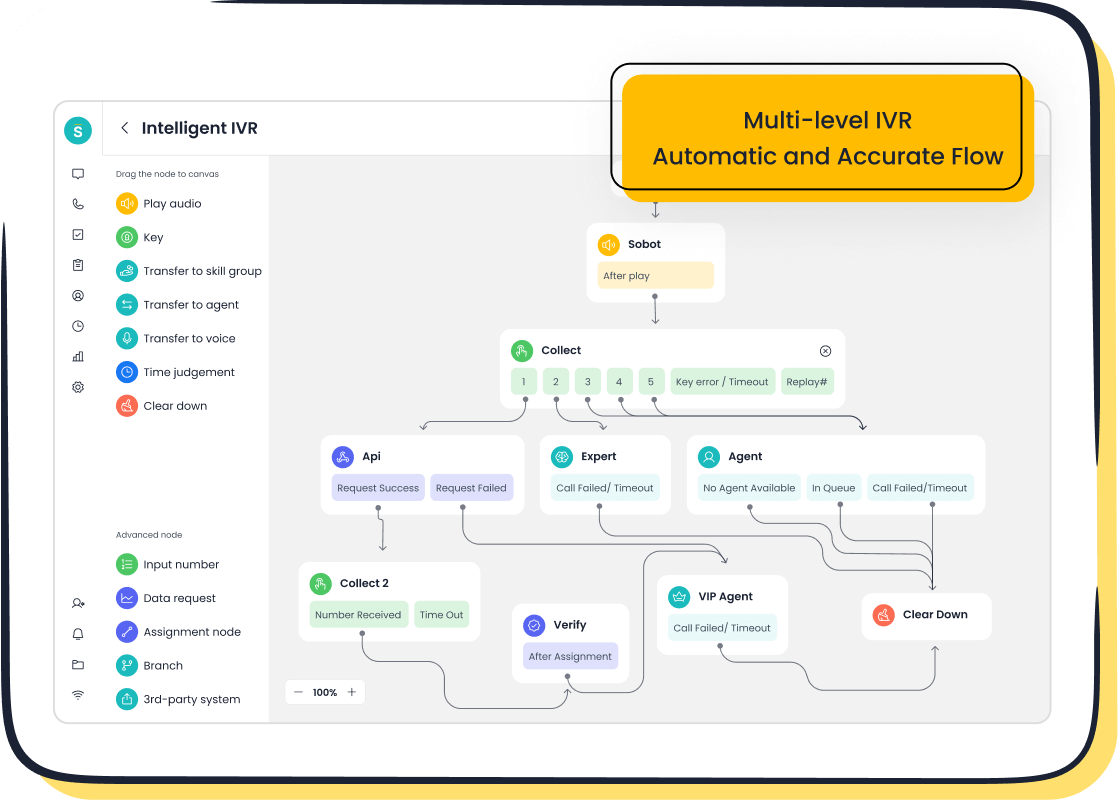
Retailers are adapting to industry standards by leveraging AI solutions like Sobot’s omnichannel support. These tools enable businesses to handle inquiries across chat, email, voice, and social media, ensuring seamless interactions. For example, Sobot AI’s scenario-based capabilities allow e-commerce platforms to provide tailored recommendations, reducing cart abandonment and boosting satisfaction.
Establishing benchmarks is essential for measuring performance and identifying areas for improvement. Retailers that prioritize customer-centric strategies, such as real-time support and personalized promotions, often achieve higher CSAT scores. As consumer expectations rise, businesses must continue innovating to maintain their competitive edge.
Healthcare and Wellness: Ensuring patient satisfaction
Patient satisfaction remains a critical metric in the healthcare and wellness industry. Studies show that factors like communication, waiting time, and perceived health status significantly influence satisfaction levels. In 2025, healthcare providers are focusing on improving these areas to enhance patient experiences.
| Study Focus | Key Determinants of Patient Satisfaction |
|---|---|
| Review of studies from 2000 to 2021 | Identified factors such as medical care, communication, waiting time, age, perceived health status, and education level as significant influences on patient satisfaction. |
| Impact on Patient Loyalty | Emphasizes that patient satisfaction is directly linked to loyalty, which affects healthcare provider recommendations and service usage. |
Healthcare providers are leveraging technology to address patient needs more effectively. For example, Sobot’s AI-powered solutions can streamline appointment scheduling, provide instant responses to inquiries, and offer personalized care recommendations. These tools help reduce waiting times and improve communication, two key drivers of satisfaction.
National surveys highlight the importance of measuring patient satisfaction to identify gaps and improve service quality. Providers that invest in training staff and adopting innovative solutions often see higher CSAT scores. By focusing on patient-centric strategies, healthcare organizations can build trust and loyalty, ensuring long-term success.
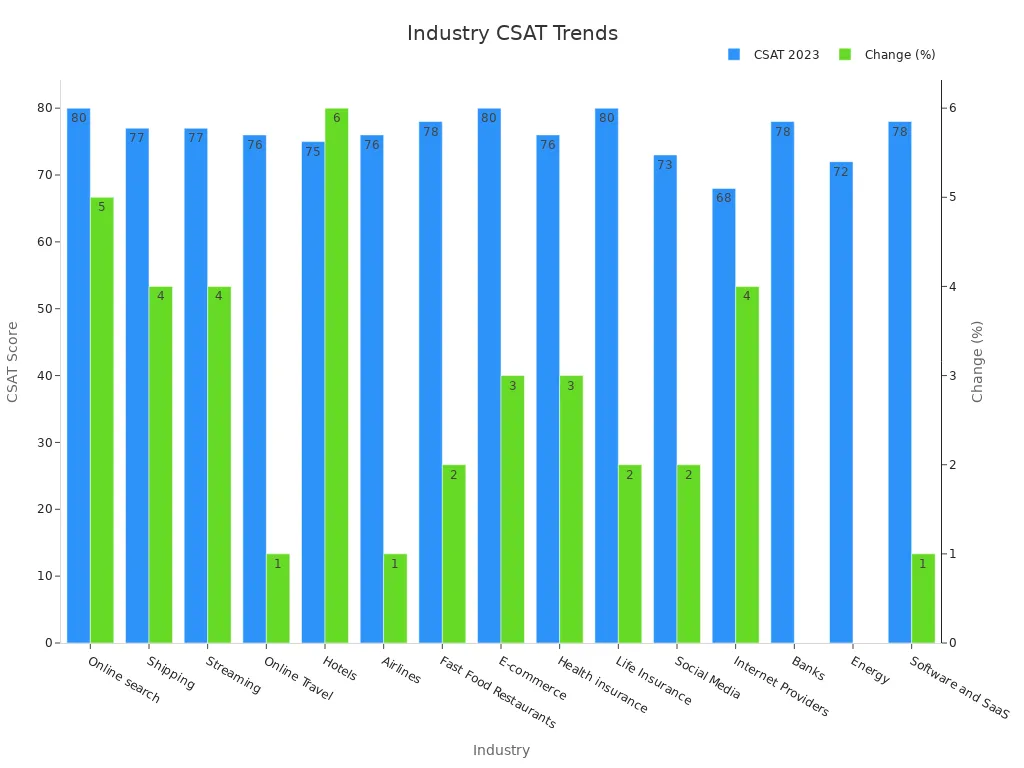
Hospitality and Travel: Delivering exceptional experiences
The hospitality and travel industry thrives on creating memorable experiences. In 2025, customer satisfaction in this sector hinges on seamless service, personalized interactions, and quick resolutions. Travelers expect more than just a comfortable stay or a smooth flight; they demand exceptional service at every touchpoint. Meeting these expectations requires businesses to adopt innovative strategies and technologies.
| Metric | Description | Impact on CSAT |
|---|---|---|
| First Call Resolution (FCR) | Resolving issues on the first attempt improves efficiency. | A 1% improvement in FCR significantly enhances CSAT. |
| Customer Effort Score (CES) | Reducing effort through predictive dialing and SMS. | Directly correlates with increased satisfaction. |
| Net Promoter Score (NPS) | Self-service options and coaching boost loyalty. | Higher NPS reflects better customer satisfaction. |
| Average Handle Time (AHT) | AI assistants reduce resolution times. | Faster service enhances customer experience. |
| Omnichannel Support | Support across multiple channels improves accessibility. | Increases overall customer satisfaction. |

To achieve these benchmarks, many businesses in this industry are leveraging AI-powered solutions. For instance, Sobot’s Voice/Call Center offers features like intelligent IVR and smart call routing, ensuring that customers connect with the right agent quickly. This reduces frustration and enhances satisfaction. Additionally, Sobot’s omnichannel support enables businesses to provide consistent service across platforms, from phone calls to social media. These tools not only improve efficiency but also foster loyalty by delivering personalized experiences.
Consider how leading brands in hospitality have embraced technology. Hilton, for example, uses AI chatbots to assist guests with bookings and inquiries, ensuring a smooth experience. Similarly, airlines are adopting predictive analytics to anticipate customer needs, such as offering rebooking options during delays. By focusing on reducing effort and enhancing convenience, the hospitality and travel industry continues to set high CSAT benchmarks.
Technology and SaaS: The role of innovation in CSAT
The technology and SaaS industry plays a pivotal role in shaping customer satisfaction trends. In 2025, innovation drives this sector, with businesses leveraging advanced tools to enhance user experiences. Customers expect seamless integrations, intuitive interfaces, and proactive support. Meeting these demands requires a focus on metrics that go beyond traditional satisfaction scores.
- Customer Effort Score (CES): Measures how easy it is for customers to interact with a service.
- Customer Engagement Score (CES): Assesses the level of customer interaction and engagement with the service.
- AI-Driven Data Analytics: Utilizes AI to analyze customer data for insights that can enhance service delivery and satisfaction.
For example, Sobot’s AI solutions empower SaaS companies to deliver exceptional service. Its AI-powered Voicebot provides instant responses, reducing average handle time and improving first-contact resolution rates. Additionally, Sobot’s data analytics tools offer actionable insights, helping businesses identify pain points and optimize their strategies. These features align with the industry's focus on innovation and efficiency.
Brands like Adobe and Salesforce have set benchmarks by integrating AI into their platforms. Adobe uses machine learning to personalize user experiences, while Salesforce employs predictive analytics to anticipate customer needs. These innovations not only improve satisfaction but also foster loyalty by addressing issues proactively.
In the SaaS industry, staying ahead means embracing technology that simplifies processes and enhances customer interactions. By adopting tools like Sobot’s omnichannel solutions, businesses can meet rising expectations and achieve higher CSAT scores.
Factors Influencing CSAT Trends in 2025
The rise of AI and automation in customer service
AI and automation are transforming how businesses approach customer satisfaction. These technologies enable you to deliver faster, more personalized interactions. AI-powered chatbots and virtual assistants provide 24/7 support, reducing wait times and resolving issues efficiently. For example, machine learning and natural language processing allow AI to understand customer needs and offer tailored solutions. This not only improves satisfaction but also enhances productivity by automating repetitive tasks.
Businesses adopting AI see significant benefits. According to Deloitte, 73% report increased productivity, while 60% experience cost reductions. AI also boosts accuracy by 44%, ensuring consistent service quality. By integrating AI into your customer service strategy, you can improve satisfaction scores by 10 to 20%. These advancements allow you to focus on complex customer interactions, fostering loyalty and trust.
Evolving customer expectations and personalization
Customer expectations are constantly changing. Today, customers demand personalized experiences that cater to their unique needs. AI plays a crucial role in meeting these expectations by analyzing data to understand behaviors across channels. For instance, leveraging data allows you to provide tailored recommendations, which 80% of customers value enough to share their information for better experiences.
To meet these expectations, you should focus on three key strategies:
- Use AI to enhance interactions and reduce response times.
- Ensure consistency across all communication channels.
- Continuously gather feedback through surveys and social media.
Tracking metrics like satisfaction scores and customer lifetime value helps you measure the impact of personalization. By adapting to evolving expectations, you can build stronger relationships and improve satisfaction.
Service accessibility and quality as key drivers
Service quality and accessibility are critical for achieving high satisfaction levels. Customers value reliability, responsiveness, and empathy in their interactions. A study in the Saudi auto care industry highlights that improving service quality dimensions directly increases satisfaction. This is especially true in the post-pandemic era, where digital communication has become the norm.
To enhance accessibility, you should integrate advanced channels like chat, email, and voice into your service strategy. Currently, 16.7% of businesses have adopted these channels, while 40% plan to invest in chatbots for call centers. Quick response times remain the most significant factor influencing satisfaction. By prioritizing accessibility and quality, you can meet customer expectations and set your business apart.
How Sobot's AI solutions align with these trends
Sobot’s AI solutions align perfectly with the latest customer service trends. These tools help you deliver faster, smarter, and more personalized experiences. By adopting Sobot’s AI-powered platform, you can meet rising expectations and improve satisfaction scores.
Sobot’s AI solutions reduce waiting times by 35%. Smart integrations ensure customers receive quick responses, minimizing frustration. Over 80% of answers provided by the platform are accurate, which builds trust and confidence. Additionally, 22.2% of inquiries are resolved independently by AI, freeing up your agents to focus on complex issues. This efficiency improves overall service quality.
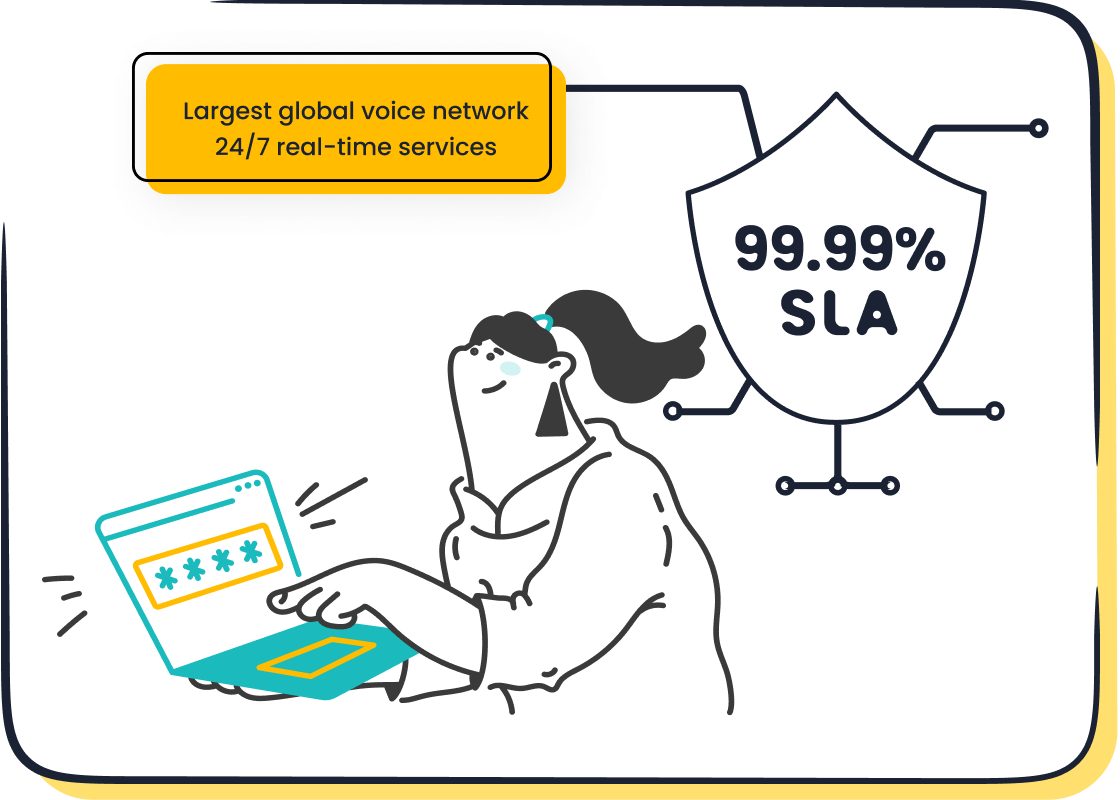
Omnichannel support is another key feature of Sobot’s platform. It eliminates disjointed systems, allowing customers to interact seamlessly across chat, email, voice, and social media. This unified approach enhances the customer experience and ensures consistent service. With 95% of customers reporting satisfaction and a CSAT score of 97%, Sobot’s solutions demonstrate their ability to meet high standards.
Personalization is essential for modern customer service. Sobot’s AI analyzes data to understand customer preferences and behaviors. This allows you to offer tailored recommendations and proactive support. For example, the platform’s AI copilots assist agents in generating personalized responses, ensuring every interaction feels unique. These features contribute to 99% of customers expressing happiness with the service.
By leveraging Sobot’s AI solutions, you can stay ahead of customer service trends. Whether you aim to reduce effort, improve accessibility, or deliver personalized experiences, Sobot provides the tools to achieve your goals.
Strategies for Improving CSAT Scores
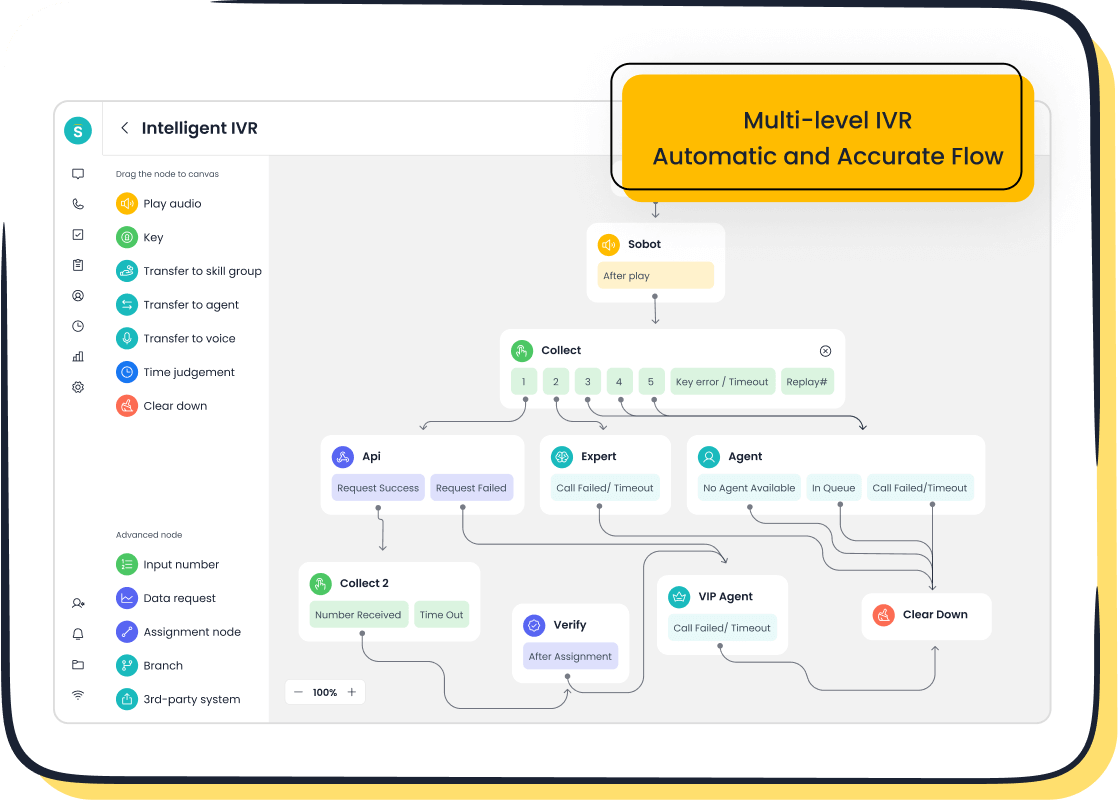
Leveraging customer feedback for actionable insights
Customer feedback is a goldmine for improving your CSAT. By actively listening to your customers, you can uncover pain points and identify opportunities to enhance their experience. Surveys are one of the most effective tools for gathering this feedback. A well-designed CSAT survey asks targeted questions that reveal how satisfied customers are with specific aspects of your service. For example, asking, "How satisfied were you with your recent interaction?" provides actionable insights into what works and what needs improvement.
Companies that act on feedback often see significant gains in satisfaction. For instance, Amazon used customer feedback to develop Amazon Prime, addressing the need for faster shipping. This innovation transformed the e-commerce industry. Similarly, an e-commerce retailer reduced cart abandonment by 25% after redesigning its checkout process based on customer input. These examples highlight how feedback can drive meaningful change.
To make the most of feedback, you should analyze it regularly and implement changes promptly. Tools like Sobot’s Voice/Call Center simplify this process by integrating customer feedback directly into your workflows. The platform’s real-time monitoring and analytics help you identify trends and measure the impact of your improvements. By leveraging feedback effectively, you can create a customer experience that consistently exceeds expectations.
Training and empowering customer service teams
Your customer service team plays a crucial role in achieving a good CSAT score. Well-trained and empowered agents can resolve issues faster, provide personalized support, and leave a lasting positive impression. Training programs that focus on communication skills, product knowledge, and problem-solving techniques are essential for building a high-performing team.
Several methodologies have proven effective in enhancing team performance. For example:
| Methodology | Impact on Performance |
|---|---|
| Lean Manufacturing | Reduces waste and optimizes resource utilization. |
| Six Sigma | Minimizes defects using data-driven techniques. |
| Agile | Encourages teamwork and open communication. |
| Kaizen | Promotes a culture of continuous improvement. |
| Business Process Management (BPM) | Provides actionable insights through metrics and analytics. |
Empowered agents also deliver better results. Organizations that invest in agent empowerment see higher CSAT scores and lower turnover rates. For example, Debit Success uses customer feedback to coach its call center teams, linking feedback directly to individual performance improvements. This approach not only boosts satisfaction but also fosters a culture of accountability and growth.
Sobot’s Voice/Call Center supports agent empowerment by providing a unified workspace where agents can access customer histories, call recordings, and AI-generated insights. These tools enable your team to deliver faster, more accurate resolutions. With features like smart call routing and AI copilots, Sobot ensures your agents have everything they need to succeed.
Using Sobot's Voice/Call Center for seamless support
Seamless support is a cornerstone of improving CSAT scores. Customers value quick, efficient service that resolves their issues without unnecessary effort. Sobot’s Voice/Call Center excels in delivering this level of support. Its intelligent IVR system ensures customers connect with the right agent quickly, reducing frustration and wait times.
The platform’s AI-powered voicebots provide instant assistance, handling repetitive queries and freeing up agents to focus on complex issues. This automation not only improves resolution rates but also enhances the overall customer experience. For example, businesses using Sobot’s omnichannel solutions report higher engagement and satisfaction levels due to the platform’s ability to unify communication across chat, email, voice, and social media.
Sobot also prioritizes accessibility and reliability. With a 99.99% system uptime and global network support, you can ensure uninterrupted service even during peak times. The platform’s real-time analytics allow you to monitor performance and make data-driven decisions to improve satisfaction. By adopting Sobot’s Voice/Call Center, you can streamline your operations and deliver the seamless support your customers expect.
Building proactive and personalized customer service models
Proactive and personalized customer service models are essential for improving csat scores and fostering long-term customer satisfaction. These models anticipate customer needs and deliver tailored solutions, creating a seamless and memorable experience. By adopting this approach, you can build stronger relationships and set your business apart from competitors.
Why proactive service matters
Proactive service focuses on addressing potential issues before they arise. Instead of waiting for customers to report problems, you take the initiative to resolve them. This approach reduces frustration and enhances satisfaction. For example, sending a notification about a delayed shipment before the customer inquires shows that you value their time and trust.
Proactive service also helps you identify trends and recurring issues. By analyzing customer interactions, you can pinpoint areas for improvement and implement changes that benefit everyone. This not only boosts csat but also strengthens your reputation as a customer-centric business.
The power of personalization
Personalization goes beyond using a customer's name in emails. It involves understanding their preferences, behaviors, and needs to deliver tailored experiences. Customers appreciate when businesses remember their past interactions and offer relevant solutions. For instance, recommending products based on previous purchases or providing customized support enhances satisfaction and loyalty.
To personalize effectively, you need access to accurate and comprehensive customer data. Tools like Sobot’s Voice/Call Center integrate with your CRM systems, giving agents a complete view of each customer’s history. This enables your team to provide personalized assistance that feels genuine and thoughtful.
Steps to build proactive and personalized models
- Leverage customer data: Use analytics to understand customer behavior and preferences. This helps you anticipate their needs and offer relevant solutions.
- Train your team: Equip your agents with the skills and tools needed to deliver proactive and personalized service. Regular training ensures they stay updated on best practices.
- Adopt advanced technology: Implement AI-powered solutions like Sobot’s Voice/Call Center to streamline interactions and provide real-time insights. These tools enhance efficiency and accuracy.
- Gather feedback: Regularly collect and analyze customer feedback to identify areas for improvement. Use this information to refine your strategies and meet evolving expectations.
- Monitor performance: Track key metrics like csat and first-contact resolution rates to measure the effectiveness of your efforts. Adjust your approach based on the results.
How Sobot supports proactive and personalized service
Sobot’s solutions empower you to deliver proactive and personalized customer service. The platform’s AI capabilities analyze customer data to predict needs and offer tailored recommendations. For example, Sobot’s AI copilots assist agents in crafting personalized responses, ensuring every interaction feels unique.
The Voice/Call Center simplifies communication by unifying all channels into one workspace. This allows agents to access customer histories and provide consistent support across chat, email, voice, and social media. Features like intelligent IVR and smart call routing ensure customers connect with the right agent quickly, reducing effort and improving satisfaction.
By adopting Sobot’s tools, you can create a proactive and personalized service model that enhances csat and builds lasting customer relationships.
Tip: Start small by personalizing one aspect of your service, such as email communication. Gradually expand your efforts as you gather more data and insights.
Challenges in Measuring and Improving CSAT
Balancing quantitative and qualitative feedback
Balancing quantitative and qualitative feedback is essential for accurately measuring your customer satisfaction score. Quantitative metrics, such as sales numbers or conversion rates, provide tangible data to identify trends and priority areas. However, these numbers alone cannot explain why customers feel a certain way. This is where qualitative feedback, gathered through csat surveys, focus groups, or open-ended questions, becomes invaluable.
For example, while a csat survey might reveal a drop in satisfaction, qualitative insights can uncover the reasons behind it, such as long wait times or unclear communication. Combining both types of data gives you a comprehensive understanding of customer experiences. Cross-referencing quantitative trends with qualitative stories also helps confirm issues and spot contradictions, improving the reliability of your insights. This balanced approach ensures your strategies address both measurable outcomes and emotional factors, leading to better satisfaction levels.
Overcoming biases in data collection
Biases in data collection can distort your csat results, making it harder to identify real issues. For instance, customers with extreme experiences—either very positive or very negative—are more likely to respond to surveys. This response bias can skew your results, leaving out the majority of customers who had neutral experiences.
Subjectivity also plays a role. Different customers interpret satisfaction differently, which can lead to inconsistent scores. Additionally, csat surveys often focus on specific interactions rather than overall loyalty, limiting their scope. To overcome these challenges, you should design surveys that encourage broader participation and include questions that capture a range of experiences. Using multiple data sources, such as transactional data and follow-up interviews, can also help reduce bias and provide a clearer picture of customer satisfaction.
| Challenge | Description |
|---|---|
| Limited context | CSAT surveys often consist of a single question, which may not capture the complexity of customer experiences. |
| Subjectivity | Customer satisfaction interpretations vary, leading to different perceptions of what 'satisfied' means. |
| Lack of detail | Standard rating scales may not adequately differentiate between levels of satisfaction. |
| Response Bias | Customers with extreme experiences are more likely to respond, skewing the results. |
Addressing industry-specific challenges in CSAT measurement
Each industry faces unique challenges when measuring csat. For example, in retail, customers expect fast responses and personalized service. In healthcare, satisfaction depends on factors like communication and wait times. These differences mean you cannot apply a one-size-fits-all approach to csat surveys.
To address these challenges, tailor your surveys to reflect the specific needs of your industry. For instance, a retail survey might focus on delivery speed and product quality, while a healthcare survey could emphasize empathy and clarity of communication. Advanced tools like Sobot’s Voice/Call Center can help by providing industry-specific insights and automating data collection. By customizing your approach, you can capture more accurate data and implement targeted strategies to improve satisfaction.
Future Predictions for CSAT Benchmarks
The role of predictive analytics in shaping CSAT
Predictive analytics is revolutionizing how businesses approach customer satisfaction. By analyzing historical data, machine learning models can forecast customer behaviors like churn or upsell potential. These insights allow you to make proactive decisions that enhance the customer experience. For example, predictive analytics can identify patterns in CSAT survey responses, helping you address recurring issues before they escalate.
Key performance indicators (KPIs) are expected to see significant improvements by 2025 due to predictive analytics. Metrics like time to resolution and average handle time will improve by over 30%, directly impacting CSAT benchmarks. The following table highlights these forecasted changes:
| KPI | Forecasted Change |
|---|---|
| Customer Satisfaction (CSAT) | 38% |
| Time to Resolution | 31% |
| Average Handle Time (AHT) | 30% |
| First Response Time | 29% |
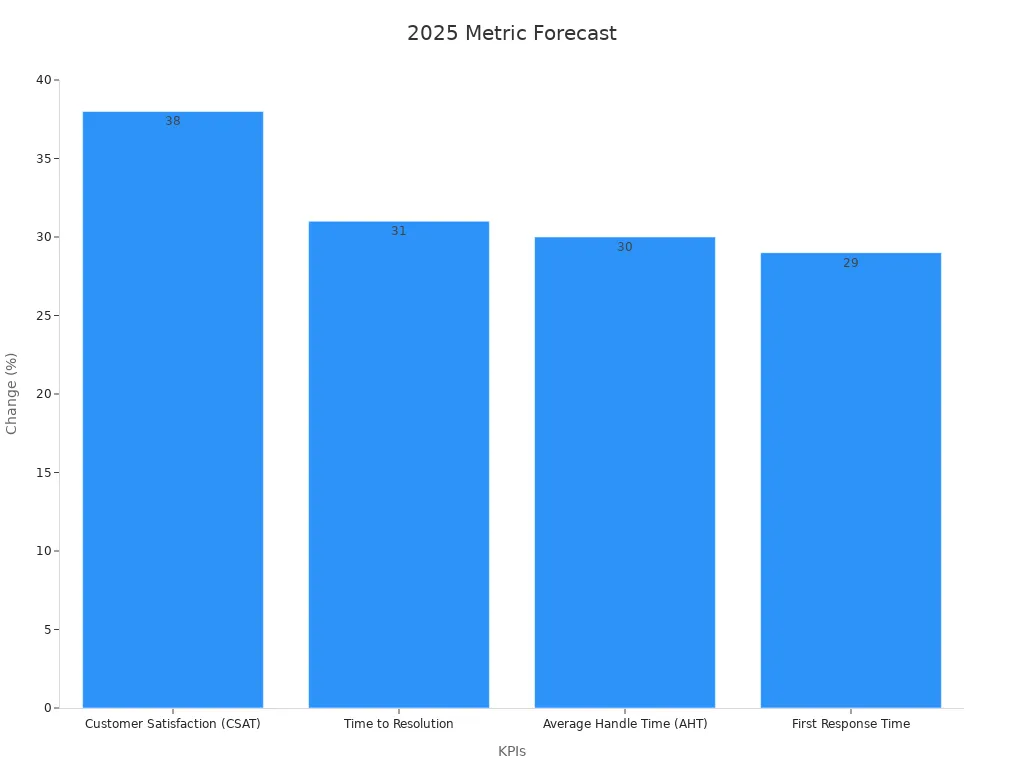
By leveraging predictive analytics, you can anticipate customer needs and deliver tailored solutions. This approach not only improves satisfaction but also strengthens loyalty.
Emerging trends in customer experience for 2025
In 2025, customer experience will be shaped by emerging trends like AI-driven personalization and proactive service. Predictive analytics will enable you to resolve issues before customers even notice them. For instance, AI can analyze CSAT survey data to predict dissatisfaction triggers, allowing you to implement solutions in advance.
Leading brands are already using AI to deliver consistent, tailored experiences. By adopting similar strategies, you can achieve up to 25% revenue growth and reduce customer acquisition costs by 50%. These trends highlight the importance of integrating advanced technologies into your customer service strategy.
Additionally, customers increasingly value seamless omnichannel support. Tools like Sobot’s Voice/Call Center unify communication across platforms, ensuring consistent service. Features like intelligent IVR and AI-powered voicebots enhance accessibility, making it easier for customers to interact with your business. These innovations will set the standard for customer satisfaction in the coming years.
Industry-specific forecasts and the role of Sobot in driving success
Different industries will experience unique CSAT trends in 2025. In banking, digital transformation will continue to drive satisfaction. Customers will expect faster resolutions and secure transactions. Predictive analytics will play a crucial role in meeting these expectations by identifying and addressing pain points.
Retail and e-commerce will focus on personalization to maintain high CSAT benchmarks. AI solutions like Sobot’s omnichannel platform will help businesses provide tailored recommendations, reducing cart abandonment and improving satisfaction. In healthcare, technology will streamline appointment scheduling and communication, enhancing patient experiences.
Sobot’s solutions align with these industry-specific needs. The platform’s AI capabilities analyze customer data to predict behaviors and offer proactive support. For example, Sobot’s Voice/Call Center reduces average handle time and improves first-contact resolution rates, directly impacting CSAT scores. By adopting Sobot’s tools, you can stay ahead of industry trends and achieve long-term success.
CSAT benchmarks for 2025 reveal valuable insights into customer satisfaction across industries. High-performing sectors like retail and e-commerce demonstrate the importance of meeting evolving expectations. To stay competitive, you must adapt to these trends and embrace technology. Tools like AI and predictive analytics simplify processes, improve interactions, and enhance satisfaction.
Sobot provides the solutions you need to achieve a good CSAT score. Its AI-powered Voice/Call Center ensures seamless communication, faster resolutions, and personalized support. By leveraging Sobot’s tools, you can exceed customer expectations and build lasting satisfaction.
FAQ
What is a good CSAT score to aim for in 2025?
A good CSAT score in 2025 typically falls between 75% and 85%. Scores above 90% indicate exceptional performance and strong customer loyalty. Aim for consistent improvement by addressing customer feedback and optimizing your service strategies.
How often should you measure CSAT?
You should measure CSAT after key customer interactions, such as purchases or support calls. Regular tracking, like monthly or quarterly, helps you identify trends and make timely improvements to enhance satisfaction.
How does Sobot help improve CSAT scores?
Sobot improves CSAT by streamlining communication with tools like intelligent IVR, AI-powered voicebots, and omnichannel support. These features reduce wait times, enhance personalization, and ensure seamless customer experiences.
Can CSAT be used alongside other metrics?
Yes, CSAT works well with metrics like NPS (Net Promoter Score) and CES (Customer Effort Score). Combining these metrics provides a comprehensive view of customer satisfaction, loyalty, and interaction ease.
Why is personalization important for CSAT?
Personalization makes customers feel valued and understood. Tailored recommendations, proactive support, and remembering past interactions improve satisfaction. Tools like Sobot’s AI solutions enable you to deliver personalized experiences efficiently.
See Also
Discovering Leading Cloud Contact Centers for 2025
Best Call Center Analytics Tools to Use in 2024
Leading Speech Analytics Solutions for Call Centers 2024
